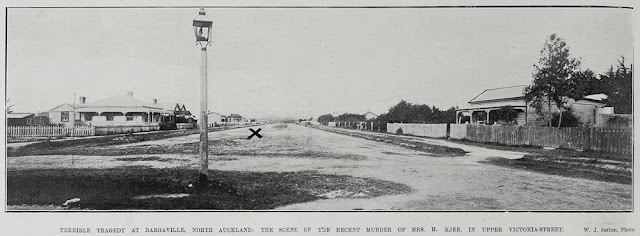The Mangawhai Breakwater - 1865
 |
| Mangawhai Breakwater on the front left of image Mangawhai Heads, Northland. Ref: WA-32393-F. Alexander Turnbull Library, Wellington, New Zealand. /records/23504651 |
Situated at the entrance to the Mangawhai Harbour is a line of rocks going out to an outcrop of rock marking the southern end of the Mangawhai surf beach. Its origins date back to May 28, 1862, when a group of settlers came together at Samuel Mooney's Mangawhai Hotel and mooted the idea of building a breakwater to improve safety for vessels entering the inner waterway. Subscriptions were advertised during 1862 in order to finance the proposed project and get it off the ground.
In 1863, Charles Haselden, secretary of the Mangawhai Harbour Improvements committee wrote to the New Zealander raising the continued problems of access into the inner harbour.
To the Editor of the New-Zealander. Sir,
— There have been lately two or three remarks in the New Zealander tending to show that the difficulties of the bar harbour, Mangawai, were somewhat mythical. Let me tell you briefly the events of the past month; One trip the Tay made with members of my family on board, and many of our new friends the Non-conformists, and she could not get in and was obliged to run to Wangarei, from which place my children and some of their fellow passengers were compelled to walk; this has occurred to my family before. A second the return trip made by the Tay has occupied three weeks. These were unsuccessful attempts to get in. During the same time Seymour, the skipper of the Three Brothers, has been lying inside unable to get out, fourteen passengers have been compelled to walk to Matakana; twenty-four others were detained from their homes waiting for the boat to go — of course at great expense; the stores have been empty as no supplies could be obtained. These are the instances of one month; and, believe me, it is no new thing—the same is constantly occurring. You are aware and the public through you that a breakwater at the heads has been proposed as a remedy, at a cost of £400; only £60 am needed now, £l40 having been subscribed by the settlers, and £200 (may I say) promised by the Provincial Government. Failing this, why cannot the road to Mahurangi be completed? There is a good harbour accessible at all times, and the distance from many of us not more than Mangawai; and a few miles more we would cheerfully travel with our drays rather than be detained at Mooney’s Inn, as we now are, for we are never told by the skipper when he will or can go.
After countless delays in obtaining government funding for the breakwater project, news came in September 1864, that funding had finally secured and work could commence once tenders were advertised. Tenders were advertised for the construction of the breakwater first in November 1864 and again in May 1865. The breakwater was designed by Daniel Simpson and supervised by engineer William Weaver. The work was undertaken by immigrants under the Waikato Settlement Scheme during the course of the same year. Further tenders for work to be completed were advertised by the Public Works Office in May 1866.
In August 1866, three quarry workers engaged for breakwater scene were killed by rockfall. Alexander Duncan, Lawrence McWatt and William Craig McWatt all died instantly and were buried in the Mangawhai Cemetery. It is unclear when the breakwater was completed, by 1876 the breakwater was described as 'being a ruin' due to several breaches by the tide.
Time and tides have slowly eroded the breakwater away; it still remains as a feature on the Mangawhai waterfront to this day.
Join us on Facebook at the Northland Heritage Group



Comments